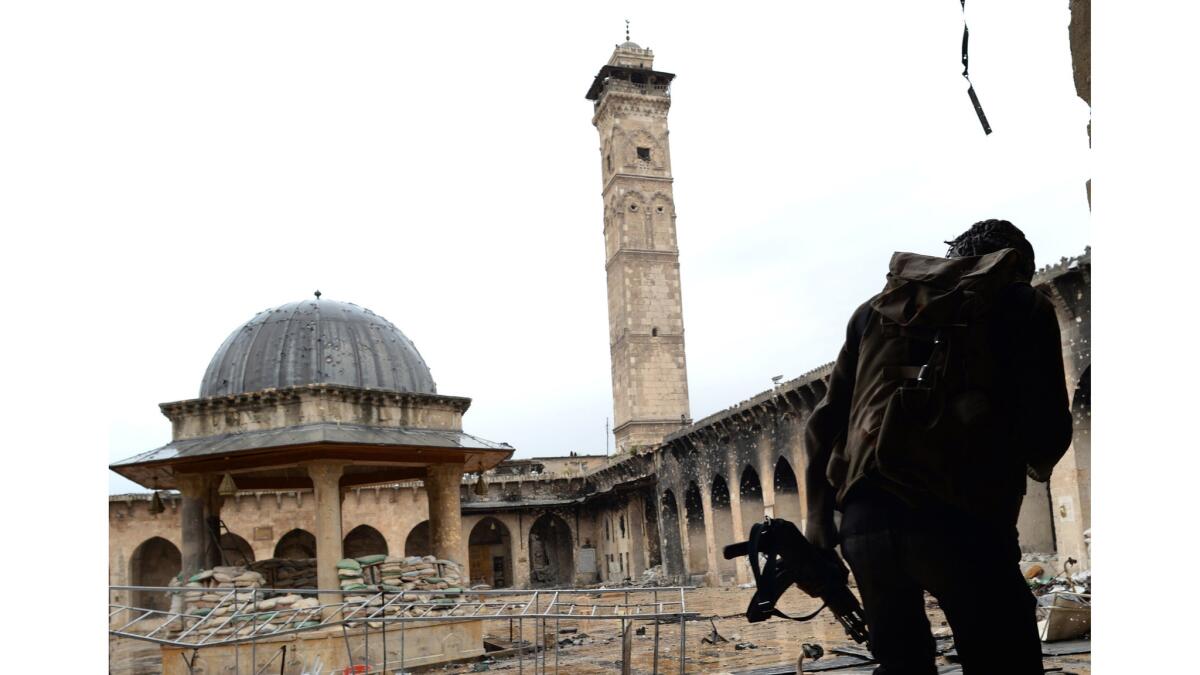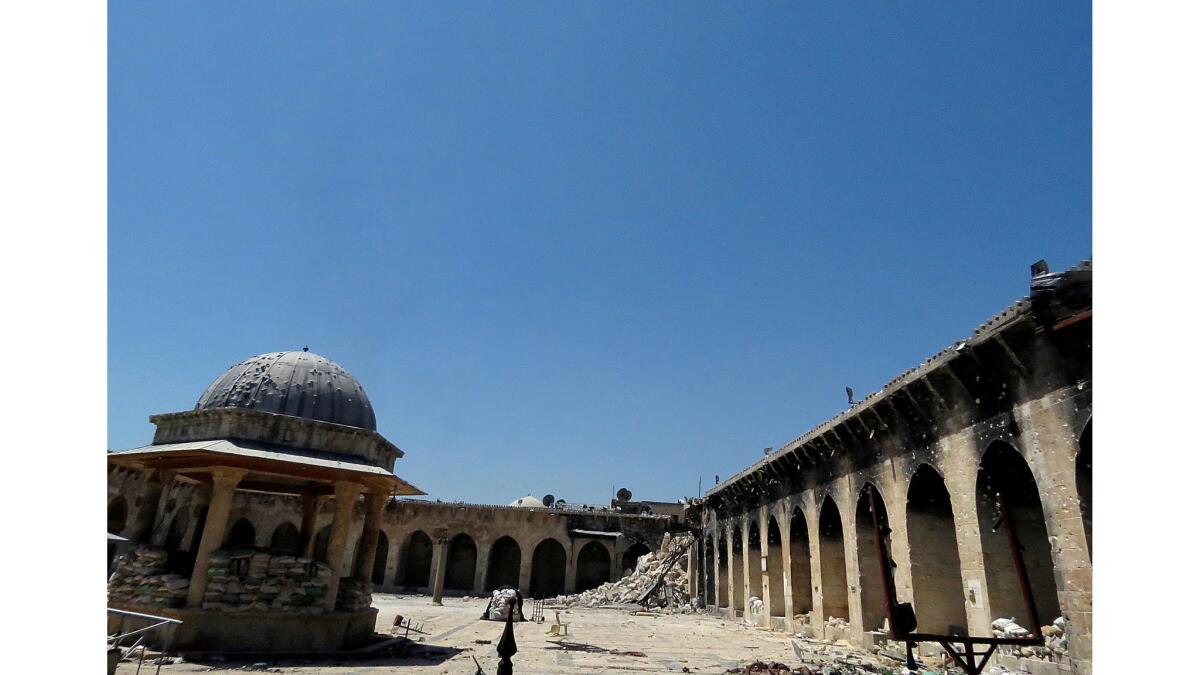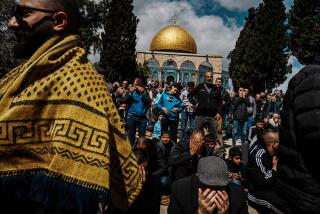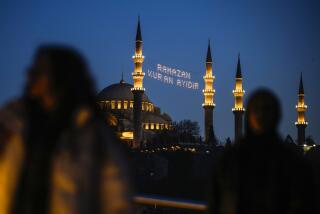‘There are no words that can describe my sadness.’ Syrians return to Aleppo to find their beloved mosque destroyed

Patrick McDonnell talks to people who remember the Great Mosque before the war in Syria.
Her face was ashen, her solemn manner suggesting a state of grief.
“It is as though we lost a close relative,” Haymen Rifai, 60, explained gravely as she stood with her two daughters in the war-pulverized center of Aleppo. “Each time we come here it feels worse.”
She had not lost a loved one, but rather a cherished, stone-and-mortar symbol: The city’s historic Umayyad mosque, which Rifai and her family had come to visit on this sun-drenched afternoon — part of a daily, if forlorn, pilgrimage to the grievously wounded house of worship in the heart of the Old City.
Another visitor, Mohammed Marsi, 41, and his son surveyed the vast courtyard once distinguished by intricate geometric designs in alternating black and white stones. Now the stones were chipped or shattered, or hidden by mud or implements of war.
“The destruction for the whole country is indescribable, just like what happened to the mosque,” said Marsi. “If you knew the mosque before the damage, and saw it now, it is like someone who lost a child or part of his body.”

The sublime mosque, along with the nearby, medieval-era covered souk, have long been synonymous with Aleppo, the core of which the United Nations declared a World Heritage site.
The mosque and the souk, along with much of the Old City, suffered calamitous harm during the more than four years that this former Silk Road hub was divided between opposition fighters and forces loyal to the government of President Bashar Assad.
The mosque, souk and adjoining districts were transformed into World War I-style front lines, featuring trenches lined with sandbags, fortified tunnels, sniper emplacements and near-daily shelling.
The mosque, once a pillar of Syria’s moderate Sunni Muslim establishment, became a kind of opposition command center, hosting jihadist luminaries such as the firebrand Al Qaeda-linked Saudi cleric Abdullah Muhaysini, who gave YouTube interviews from the stately courtyard.
Construction on the earliest mosque on the site began in 715, and through the centuries the complex has been rebuilt and renovated again and again after earthquakes and fires, looting and war. The mosque’s signature minaret, nearly 150 tall, had survived since 1090.
But in April 2013, clashes reduced the minaret to a pile of rubble and also collapsed the mosque complex’s northwest wall. The rebels blamed Syrian forces. Syria blamed the rebels.


But the huge scale of destruction only began to become clear to the outside world in December.That’s when opposition fighters and their supporters finally decamped from their last strongholds in Aleppo city after months of government bombardment.
Since December, thousands of Aleppo residents who fled the city have returned from their places of exile. For many returnees, among the first stops has been the Old City and the beloved Umayyad mosque. Visiting here has become a rite of passage for individuals and families.
“This is the first time for me to come to the mosque since the war and I was really shocked,” Soha Alkhatib, 54, said. “I saw a lot of pictures of the mosque on the Internet, but I didn’t expect to see this amount of damage. There are no words that can describe my sadness, my pain.”
Though cleanup efforts have been underway for months, its walls remain riddled with bullet holes and pocked with shrapnel. Sandbags and 55-gallon drums filled with dirt mark where opposition fighters dug in against relentless government bombardment. Bullets and blasts have damaged some of the regal interior chandeliers, though many remain intact.

A pair of washing or ablution fountains in the courtyard still stand, but are shot through and through. Gouges from bullets and shells mar the elegant porticoes and grand wooden front doors.
Still, the people come. And still, it is their mosque.
“I have always visited to this mosque, its feel, its smell — it is the essence of Aleppo,” said Abdullah Bayoud, 56, a truck driver who was among the many stopping to pray at the walled-off shrine inside the mosque said to contain a relic of Zacarias, a prophet and father of John the Baptist in Islamic belief.
“Zacaria is the protector of Aleppo,” said Bayoud, a father of 7 who, like so many others here, fled his home during the fighting. “He is with our city.”

Both the mosque and the souk, shielded by stone walls at times more than three feet thick, appear structurally sound, despite the immense damage. But restoration is a huge undertaking that will take years, officials say, and cost many millions of dollars. Full repair will likely await the end of a war now into its seventh year.
While Aleppo is now firmly in government hands, rebels remain dug in just west of the city, still in shelling range of various neighborhoods. Ambulances regularly screech through the streets with war victims.
The citizens of Aleppo, however, point out that their august city — called Halab in Arabic and regarded as one of the longest continuously habituated areas on Earth — has come back from previous calamities, including 13th century Mongol sackings. And there are many signs of recovery.
Schoolchildren now scamper about the esplanade of the nearby Citadel, a medieval fortress that remained in government hands throughout the war. Notices posted outside the Citadel’s walls advise visitors to watch out for unexploded grenades and mortar shells. Other signs proclaim “Welcome Back” in English and Arabic, and plug a government-backed social media campaign with the hashtag title: #Believe_In_Aleppo.
Down the street, workers are removing the mound of debris that marks the site of the once-luxurious Carlton Hotel, blown up by rebels who tunneled beneath the structure in May 2014 and set off a huge bomb.

Meantime, the people of Aleppo, and visitors, inevitably make their way to Umayyad mosque to say a prayer, contemplate its splendor, its history and its near-ruin, or just reconnect with one of the region’s iconic sites.
Among those paying their respect one April day was Syria’s chief Sunni cleric, or grand mufti, Ahmed Badr al-Din Hassoun, who had earlier hailed the government’s recapture of “the crown of Aleppo.” The mufti, a key ally of the Assad government and long a would-be target of opposition assassins, arrived in a convoy of more than a dozen vehicles, mostly ferrying bodyguards with microphones in their ears, submachine guns in their arms and pistols in their belts.
Another recent visitor was Eva Jabbour, her presence a reminder that the mosque’s beauty and majesty, even now, transcend sectarian lines. She is Christian.
“This place is so important for all people of Aleppo, whatever their belief or sect,” said Jabbour, 60. “It is here for all of us. Our most profound hope is that the Great Mosque will be rebuilt, and be even better than it was before.”
Also stopping by were a pair of towering Russian soldiers, part of a substantial Russian force backing Assad’s government. Upon exiting, one Russian showed his respect for this ravaged house of worship in the best way he knew how. He made the sign of the cross.
twitter: @mcdneville
Liliana Nieto del Rio contributed to this report.
MORE WORLD NEWS
Hope. Concern. Resignation. Afghans hold divergent views about the prospect of more U.S. troops
Seven striking statistics on the status of gay rights and homophobia across the globe
Microsoft president blasts NSA for its role in ‘WannaCry’ computer ransom attack
More to Read
Start your day right
Sign up for Essential California for news, features and recommendations from the L.A. Times and beyond in your inbox six days a week.
You may occasionally receive promotional content from the Los Angeles Times.






